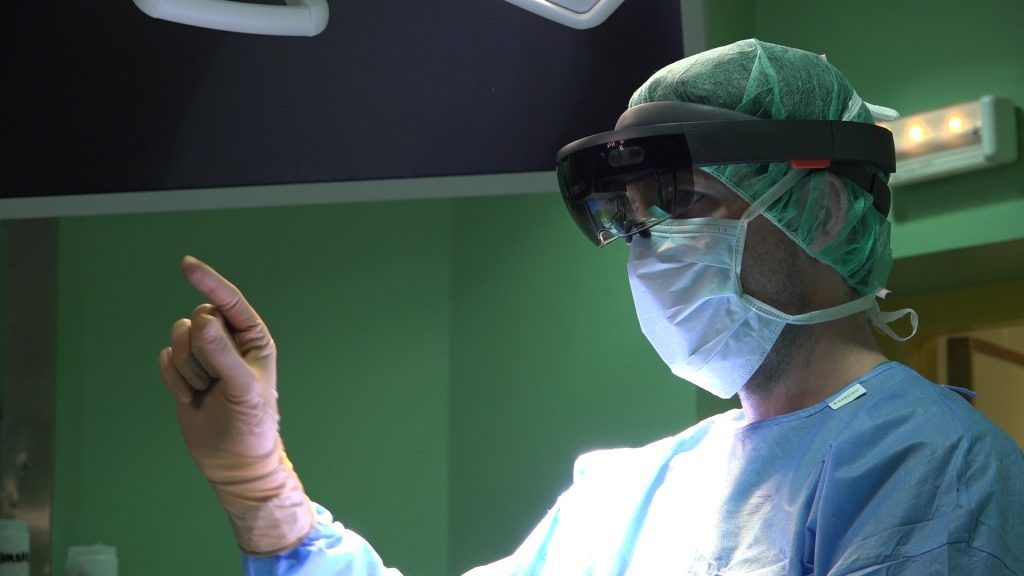Not all surgeons like to talk whilst they are operating. Trauma and orthopaedics consultant Nick Cooke is happy to – keeping up a steady flow of informative and sometimes funny chat to students watching him work.
The students are not clustered around, in theatre. They are watching a real-time stream of his operation via Teams in an upstairs room, where Nick’s colleague Jean Angus, head of nursing education, is also offering her insight – and curating questions that the surgeon is responding to as he works, via a headset with a built-in camera, earpiece and microphone.
Traditional placements in operating theatres are highly sought-after, but when students do make it in, space and safety restrictions often mean that they are only getting a partial or obstructed view of the procedure.
Nick and Jean, from North Tees and Hartlepool NHS Foundation Trust, are using RealWear headsets and software to help immerse students in a theatre training environment – with Nick streaming his actions to a large screen and taking real-time questions from students using the technology.

The project comes as an NHS England Workforce Plan aims to tackle a chronic skills shortage in the NHS and, the two say, has helped their NHS Trust get more students visual and interactive operating theatre experience in a single day than is typically made available in a year.
Nick tells The Stack: “I’ve been a consultant in the Trust now for about 17 years. I specialise in hip and knee replacements and trauma. I do about 300-400 joints a year. One of the things that has always enthused me is teaching, and we have a huge number of students coming through.
"But it's difficult to give them a theatre experience. It's easy on the ward around a patient, but it's not so easy in theatre where you have a sterile environment in which you have to be very careful,” he adds.
Jean explains: “Even in theatre, students are often in the corner and can’t really see what’s going on – generally we open up the skin and it’s down a little hole. There’s a massive shortage of theatre nurses in the country, which is stopping operations going ahead,” she adds.
“ So we came up with an idea of using a camera and streaming live surgery to around 30 students upstairs… it’s a completely interactive experience and when Nick is putting implants in [the stream is clear enough that we can] actually read the writing on the implants.”

The two started out by trying a Microsoft Hololens headset for the surgery streaming but, as Nick recalls: “It's a massive thing… It's literally a computer on your head. It’s very, very clever technology, but it has some downsides, including a fixed camera: You've got to physically tilt your whole head down into the wound for it to work. All I was being told was ‘put your head down! Put your head down! Put your head down!’ And it's very heavy, so that that didn't really work very well.”
They settled for a more lightweight headset from US company RealWear, which featured an adjustable camera, a small screen that shows Nick what his students are seeing and voice-activated commands; e.g. he can tell the camera to zoom in when necessary.
That was one problem solved. The next was patchy Wi-Fi.
“NHS Wi-FI is not as optimal as we think it is…” says Jean, somewhat wearily.
“I think that’s the best way to describe it. We were having great problems live streaming from the ground floor to the first floor in the same building” she says, adding a little more sympathetically, that “theatres have thick walls and often have lead in them to stop X-Rays.”
See also: NHS data strategy lauded for "rare willingness to move beyond aphorisms"
They opted for a dedicated network powered by an in-device SIM card, which resolved that problem, but the next one was bureaucracy, of which they suggest, diplomatically, that there was a very great deal…
All patients have opted in (hence the focus for now on pre-booked hip and knee replacement operations; the Trust also has permission from one expectant mother to stream a Caesarean section in the near future and is exploring trauma surgery options.) All identifying features are also obfuscated. No faces are shown and no names used, for example.
Even with these safeguards and with patient opt-in, issues remain.
Nick says: “Information governance will not let us record at all and we are not allowed to stream outside the Trust. Jean and I laugh at each other sometimes. One of the questions that information governance asked us was ‘which satellite we are using?’ I don’t know: It’s called ‘Fred’ and it’s up in the air?!” he says wryly. “It’s taken us a year to get the information governance arranged so we can live stream it…”
There are clearly frustrations here, but the local streaming limitations are come with an important silver lining. After all, he likes, he says, to “go and talk to the students personally” before and after the operation.

“I give them some implants to hand around. They like to actually see the surgeon before; it engages them” he explains to The Stack, as Jean adds that for others looking to replicate the programme, having the right consultant engaged is critical; someone happy to talk, who enjoys teaching and is able to communicate clearly whilst operating.
As Nick adds: “I can operate and talk at the same time. Some people can't. A good thing about hip replacements also is that they take about an hour. A five-hour operation would not be a great thing to do.
“Also I'm using saws and drills and hammers and stuff. So it's a bit different all the time; its interactive and physical from my point of view, which makes it more interesting from the students point of view.”
Returning to the hardware and software in question, Jean emphasises that setup (information governance and Wi-Fi aside) was mercifully simple: “ I was going to say, you couldn't possibly get two people who know less about technology! That's why it's a really sellable thing; because the only information I know about computers is if you turn them off and turn them back on again, it usually improves things.”
She adds: “People often think theatre is very scary and confrontational. It can be at times. But it's not the way we do it and I think that's why it’s a very unique experience. We’ve put 200 students through. We get such positive feedback and we've actually got a waiting list of people.”
The Trust has four RealWear headsets. It’s now exploring how it can use more: “There's potential for it to be used in Orthopaedics, intensive care, maternity and other areas. The biggest limitation we've got is the information governance that surrounds this, because patient confidentiality is paramount” Jean says. “We’re developing it but we have to be cautious in how we’re developing it to avoid a breach.”









